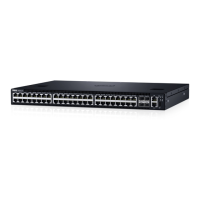Extended Address Space
The address format is extended from 32 bits to 128 bits. This not only provides room for all anticipated needs, it allows for the use of a
hierarchical address space structure to optimize global addressing.
Stateless Autoconguration
When a booting device comes up in IPv6 and asks for its network prex, the device can get the prex (or prexes) from an IPv6 router on
its link. It can then autocongure one or more global IPv6 addresses by using either the MAC address or a private random number to build
its unique IPv6 address.
Stateless autoconguration uses three mechanisms for IPv6 address conguration:
• Prex Advertisement — Routers use “Router Advertisement” messages to announce the network prex. Hosts then use their
interface-identier MAC address to generate their own valid IPv6 address.
• Duplicate Address Detection (DAD) — Before conguring its IPv6 address, an IPv6 host node device checks whether that address is
used anywhere on the network using this mechanism.
• Prex Renumbering — Useful in transparent renumbering of hosts in the network when an organization changes its service provider.
NOTE: As an alternative to stateless autoconguration, network hosts can obtain their IPv6 addresses using the dynamic host
control protocol (DHCP) servers via stateful auto-conguration.
NOTE: Dell Networking OS provides the exibility to add prexes on Router Advertisements (RA) to advertise responses to
Router Solicitations (RS). By default, RA response messages are sent when an RS message is received.
Dell Networking OS manipulation of IPv6 stateless autoconguration supports the router side only. Neighbor discovery (ND) messages are
advertised so the neighbor can use this information to auto-congure its address. However, received ND messages are not used to create
an IPv6 address.
NOTE
: Inconsistencies in router advertisement values between routers are logged per RFC 4861. The values checked for
consistency include:
• Cur Hop limit
• M and O ags
• Reachable time
• Retrans timer
• MTU options
• Preferred and valid lifetime values for the same prex
Only management ports support stateless auto-conguration as a host.
The router redirect functionality in the neighbor discovery protocol (NDP) is similar to IPv4 router redirect messages. NDP uses ICMPv6
redirect messages (Type 137) to inform nodes that a better router exists on the link.
IPv6 Headers
The IPv6 header has a xed length of 40 bytes. This xed length provides 16 bytes each for source and destination information and 8 bytes
for general header information.
The IPv6 header includes the following elds:
• Version (4 bits)
• Trac Class (8 bits)
IPv6 Routing
377

